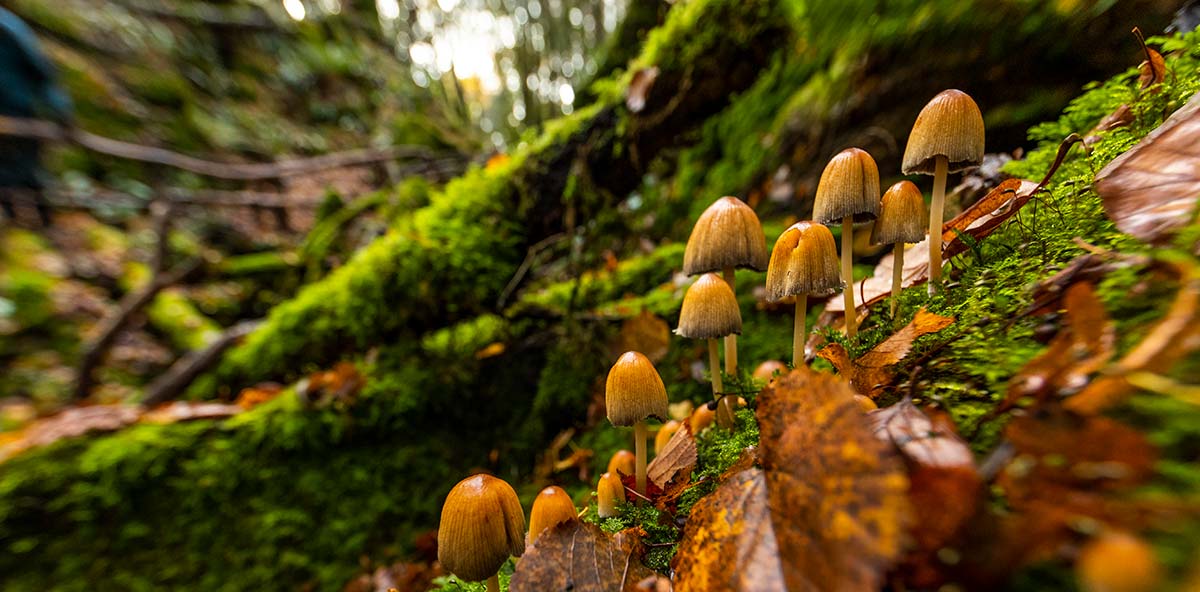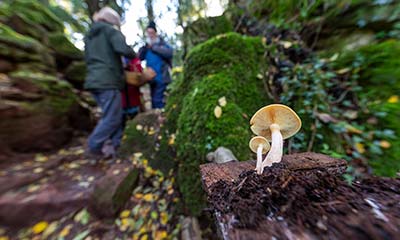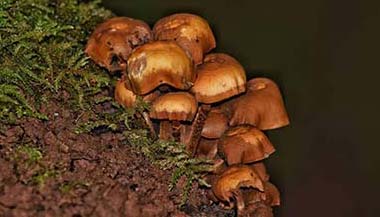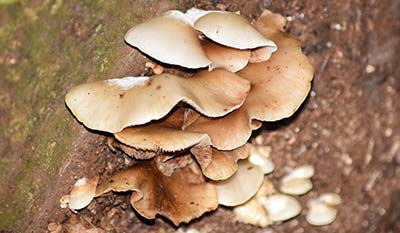
Occupying a strange nether world of neither plants nor animals these enigmatic fruiting bodies of extensive underground networks have always held a fascination for me.
These mushrooms, toadstools, slimes, yeasts and moulds are the very life of the forest and crucial to nature's wellbeing breaking down, as they do, even the mightiest fallen oak and feeding it back to the earth to begin the cycle all over again.

Fungi are seemingly as obvious a sign of autumn as turning leaves. Whilst abundant in autumn, fungi are working hard year-round and you’ll just as likely find one species or another in every nook and cranny of nature. We live in a fabulous place to explore for fungi and there is one unique habitat in the Forest where yew trees crawl over deep scowles – Puzzlewood. Here the geology and most importantly the woodland management of this unique site make it a hotspot for fungi and fungirl alike.
What a great opportunity then to accompany the Dean Fungus Group of friendly fungi experts and enthusiasts on a mycological exploration of Puzzlewood. Helen O’Kane graciously allowed access when the woods were closed to the public and had ample time to explore, although there is always the deadline of a pub lunch which follows every successful foray by the group! In the three hours of our visit we managed to identify 40 species of mushroom and another 15 species of lichen were identified by lichen expert Juliet Bailey. One of the lichens, Gyalecta jenensis, found at Puzzlewood was first record west of the Severn, and only the sixth modern record in the county!

Especially interesting also is that a Fungarium Collections Curator at Royal Botanic Gardens, Kew, spends her holidays in the area and visited Puzzlewood recently and took some samples back to the famous horticultural HQ for analysis. Some have now been identified and incorporated into their collection.
Although this famous visitor attraction does corral the visitors along the paths for safety reasons, this leaves the rest of the woodland, most of which is visible, in its pristine natural state. Any fallen timber remains in situ to be taken over by the moss and tree saplings. If all of this apparent chaos brings out your tidying gene, just remember that wildlife loves this type of thing and fastidious tidiness is not good for natural diversity!
I have been photographing “shrooms” for years and although I have a fairly comprehensive reference book, fungi can be notoriously difficult and time consuming to accurately identify.
I introduce myself to other fungi folk as an “eater” and photographer when asked about my fungi knowledge because I love them but, and here is the H&S caveat for those daft enough to try something unidentified – Any doubt at all? Don’t eat it.

In this friendly and knowledgeable Dean Fungus Group, I have learned so much as we foray a different part of the Forest each month. There is a network of such groups around the country and we were joined by two from the Cotswold group intrigued to see what Puzzlewood might produce. The more experienced members of the group arrive at positive identifications by taking spore prints, checking under the microscope, their wide experience and sometimes smell. Yes, some have really unusual aromas – who knew?
To learn more about them see Dean Fungus Group.
Written by David Broadbent.
Species of mushroom identified:
| Agaricus moelleri | Angiosperm Soil & Leaf litter | |
| Armillaria mellea | Angiosperm Wood decorticated | |
| Clitocybe geotropa | Angiosperm Soil & Leaf litter | |
| Clitocybe nebularis | Angiosperm Soil & Leaf litter | |
| Coprinellus micaceus | Angiosperm Wood stump | |
| Crepidotus variabilis | Angiosperm Wood branch fallen | |
| Galerina marginata | Taxus baccata Wood branch fallen | |
| Gymnopilus penetrans | Taxus baccata Wood branch fallen | |
| Hypholoma fasciculare var. fasciculare | Angiosperm Wood stump | |
| Kuehneromyces mutabilis | Angiosperm Wood stump | |
| Lepiota castanea | Angiosperm Soil & Leaf litter | |
| Lepiota pseudolilacea | Angiosperm Soil & Leaf litter | |
| Macrocystidia cucumis | Angiosperm Soil & Leaf litter | |
| Marasmius anomalus | Angiosperm Soil & Leaf litter | |
| Mycena epipterygia | Angiosperm Wood moss-covered | |
| Mycena rosea | Angiosperm Soil & Leaf litter | |
| Panellus stipticus | Angiosperm Wood branch fallen | |
| Pholiota squarrosa | Angiosperm Wood stump | |
| Rhodocollybia butyracea | Angiosperm Soil & Leaf litter | |
| Amylostereum laevigatum | Taxus baccata Bark dead | |
| Gloeophyllum sepiarium | Taxus baccata Wood branch fallen | |
| Hymenochaete rubiginosa | Angiosperm Wood trunk fallen | |
| Phlebia radiata | Angiosperm Wood trunk fallen | |
| Piptoporus betulinus | Betula pendula Wood trunk fallen | |
| Stereum hirsutum | Angiosperm Wood trunk fallen | |
| Trametes versicolor | Angiosperm Wood trunk fallen | |
| Auricularia mesenterica | Angiosperm Wood trunk fallen | |
| Calocera viscosa | Taxus baccata Wood branch fallen | |
| Lycoperdon pyriforme | Angiosperm Wood stump | |
| Exidia glandulosa | Angiosperm Wood branch fallen | |
| Exidia nucleata | Hedera helix Wood trunk fallen | |
| Ascocoryne sarcoides | Acer pseudoplatanusWood trunk felled | |
| Bisporella citrina | Angiosperm Wood branch fallen | |
| Lachnum niveum | Angiosperm Wood branch fallen | |
| Neonectria coccinea | Taxus baccata Bark dead | |
| Peziza varia | Angiosperm Soil & Leaf litter | |
| Daldinia concentrica | Fraxinus excelsiorWood trunk fallen | |
| Xylaria hypoxylon | Angiosperm Wood trunk fallen | |
| Lycogala terrestre | Angiosperm Wood trunk fallen | |
Species of lichen on rock faces: |
||
| Botryolepraria lesdainii | Yalecta jenensis | |
| Lepraria finkii | Lepraria incana s. str. | |
| Verrucaria elaeina | ||
Species of lichen on tree trunks and fallen twigs: |
||
| Arthonia radiata | Fuscidea lightfootii | |
| Evernia prunastri | Graphis scripta | |
| Hypotrachyna revoluta s. str. | Lecidella elaeochroma | |
| Melanelixia subaurifera | Parmelia sulcata | |
| Phaeographis smithii | Thelotrema lepadinum |







